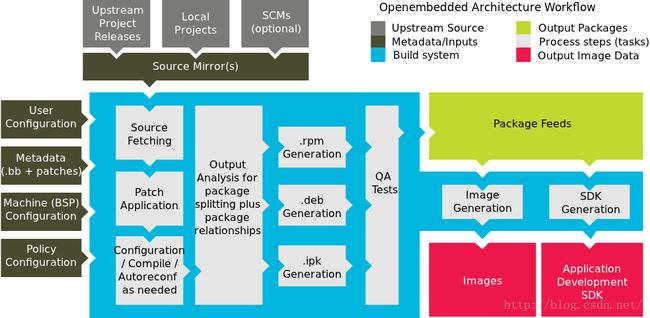Yocto Project 快速入门指南
原文:http://www.yoctoproject.org/docs/current/yocto-project-qs/yocto-project-qs.html
Yocto Project 快速入门
Copyright © 2010-2016 Linux Foundation
Permission is granted to copy, distribute and/or modify this document under the terms of the Creative Commons Attribution-Share Alike 2.0 UK: England & Wales as published by Creative Commons.
注意:
For the latest version of this manual associated with this Yocto Project release, see the Yocto Project Quick Start from the Yocto Project website.
欢迎!
Welcome to the Yocto Project! The Yocto Project is an open-source collaboration project whose focus is developers of embedded Linux systems. Among other things, the Yocto Project uses a build host based on the OpenEmbedded (OE) project, which uses the BitBake tool, to construct complete Linux images. The BitBake and OE components are combined together to form a reference build host, historically known as Poky.
If you do not have a system that runs Linux and you want to give the Yocto Project a test run, you might consider using the Yocto Project Build Appliance. The Build Appliance allows you to build and boot a custom embedded Linux image with the Yocto Project using a non-Linux development system. See the Yocto Project Build Appliance for more information.
This quick start is written so that you can quickly get a build host set up to use the Yocto Project and then build some Linux images. Rather than go into great detail about the Yocto Project and its many capabilities, this quick start provides the minimal information you need to try out the Yocto Project using a supported Linux build host. Reading and using the quick start should result in you having a basic understanding of what the Yocto Project is and how to use some of its core components. You will also have worked through steps to produce two images: one that is suitable for emulation and one that boots on actual hardware. The examples highlight the ease with which you can use the Yocto Project to create images for multiple types of hardware.
For more detailed information on the Yocto Project, you can reference these resources:
- Website: The Yocto Project Website provides the latest builds, breaking news, full development documentation, and access to a rich Yocto Project Development Community into which you can tap.
- FAQs: Lists commonly asked Yocto Project questions and answers. You can find two FAQs: Yocto Project FAQ on a wiki, and the “FAQ” chapter in the Yocto Project Reference Manual.
- Developer Screencast: The Getting Started with the Yocto Project - New Developer Screencast Tutorial provides a 30-minute video created for users unfamiliar with the Yocto Project but familiar with Linux build hosts. While this screencast is somewhat dated, the introductory and fundamental concepts are useful for the beginner.
简单介绍 Yocto Project 开发环境
The Yocto Project through the OpenEmbedded build system provides an open source development environment targeting the ARM, MIPS, PowerPC, and x86 architectures for a variety of platforms including x86-64 and emulated ones. You can use components from the Yocto Project to design, develop, build, debug, simulate, and test the complete software stack using Linux, the X Window System, GTK+ frameworks, and Qt frameworks.

Here are some highlights for the Yocto Project:
- Provides a recent Linux kernel along with a set of system commands and libraries suitable for the embedded environment.
- Makes available system components such as X11, GTK+, Qt, Clutter, and SDL (among others) so you can create a rich user experience on devices that have display hardware. For devices that do not have a display or where you wish to use alternative UI frameworks, these components need not be installed.
- Creates a focused and stable core compatible with the OpenEmbedded project with which you can easily and reliably build and develop.
- Fully supports a wide range of hardware and device emulation through the Quick EMUlator (QEMU).
- Provides a layer mechanism that allows you to easily extend the system, make customizations, and keep them organized.
You can use the Yocto Project to generate images for many kinds of devices. As mentioned earlier, the Yocto Project supports creation of reference images that you can boot within and emulate using QEMU. The standard example machines target QEMU full-system emulation for 32-bit and 64-bit variants of x86, ARM, MIPS, and PowerPC architectures. Beyond emulation, you can use the layer mechanism to extend support to just about any platform that Linux can run on and that a toolchain can target.
Another Yocto Project feature is the Sato reference User Interface. This optional UI that is based on GTK+ is intended for devices with restricted screen sizes and is included as part of the OpenEmbedded Core layer so that developers can test parts of the software stack.
Setting Up to Use the Yocto Project
为了在基于 Linux 操作系统的宿主机上使用 Yocto Project 来构建系统映像,需要满足如下列表所示的要求:
- Build Host A build host with a minimum of 50 Gbytes of free disk space that is running a supported Linux distribution (i.e. recent releases of Fedora, openSUSE, CentOS, Debian, or Ubuntu). 确保使用一个至少有 50GB 空闲空间的磁盘。建议空闲空间是 100GB。
- Build Host Packages Appropriate packages installed on the build host.
- The Yocto Project A release of the Yocto Project.
Linux 发行版
The Yocto Project team verifies each release against recent versions of the most popular Linux distributions that provide stable releases. In general, if you have the current release minus one of the following distributions, you should have no problems.
- Ubuntu
- Fedora
- openSUSE
- CentOS
- Debian
(未完待续)